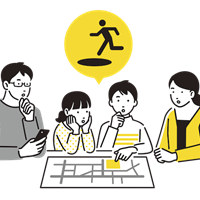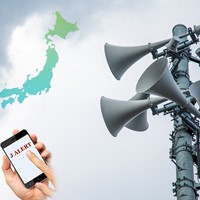What to do in Case of an Earthquake: Safety and Evacuation

Japan is one of the most earthquake-prone countries in the world, with research showing that there is a 70% probability that one might occur right below Tokyo within the next 30 years. Given that, it is highly advisable to get familiar with what to do in case of an earthquake or earthquake-related emergency in Tokyo. This article will go through the steps of what to do when an earthquake actually strikes, what to do in the aftermath should your residence become unlivable, and how to get information and stay contactable during such an emergency.
What to do in Case of an Earthquake
How to React at Home

Keep out of Range of Falling Objects
Move quickly to a spot in your home that is not likely to be in the radius of falling or collapsing objects. Objects of considerable size such as your microwave and such electronics could be projected your way, and tall furniture such as shelves or refrigerators could topple on you and pin you to the ground, so stay clear of these objects as much as possible.
If you are in the bedroom during the quake, cover your head with a pillow or blanket, and if you wear spectacles, reach for them so that they are not damaged. When considering what to do in case of an earthquake at home, your top priority is obviously to keep yourself and your family safe.
When the quake subsides, try to clear any fallen debris that may cause injury such as glass or ceramics, etc. It is advisable to wear a pair of thick slippers when doing this.In the event of an electricity blackout, it would be handy to have a source of light, in the form of a safety flashlight or lamp handy.
Switch off the gas
If any gas was in use during the quake, turn it off. Also, if any fire occurred as a result, calmly extinguish it.
Ensure your exit is clear
Strong quakes may cause obstacles to obstruct your doorway. Make sure that your doors and windows can be opened.
Keep a safe distance from danger spots
Outside your home, bricks and glass could still collapse at any moment, so try to keep a safe distance from structures prone to have parts falling off them.
Live in emergency mode
Even if it is deemed safe to take shelter at home, preparing for an earthquake often involves having extra supplies on hand. You should have gas burners, bottled water, battery operated light sources, canned or dried emergency foods, and if possible, even a portable toilet.
Please also refer to Disaster Preparedness Tokyo - Simulation of a Major Earthquake
How to react Outside your Home
Of course, many of the above tips apply whether you are at home or not; that said, preparing for earthquakes means anticipating what you might have to do in a number of situations and settings including the office, school, or even wide-open outdoor spaces.
If you are in the office, keep clear of furniture on wheels that could come freewheeling your way during any tremor. If you are out on the street, try to head to open spaces or gardens, away from tall buildings, and try to avoid old-looking structures for newer concrete ones.
In places such as a school setting, keep under the desk and hold onto the legs of the desk while taking cover. Try to keep as far away from windows as possible. If you are in a train station, take care to stay away from potentially falling objects such as signboards, and be careful not to be pushed into or fall onto the tracks.
If you are underground, stay calm and follow instructions to exit the station, as a stampede is a potential danger. If you are in the train, cover your head with your bag if you are seated, and if you are standing adopt a low, crouching position, if the train is too crowded to do so, hold on to the handrails tightly and try to keep your balance.
A Note on Clothing
Clothing is a vital component of preparing for earthquakes. Clothing that is easy to walk around in, together with good walking shoes, are obviously ideal during a disaster. No matter the season, remember that it usually gets cooler at night, so it is wise to have at least a jacket or heavy sweater on hand as well.
If you truly want to be safe, helmets and a sturdy pair of work gloves are also recommended. Of course, as you will not likely have time to prepare all of this in the heat of the moment, having an emergency pack.
>> Stockpiling and Emergency Food in Japan
Preparing for Earthquakes through Following Evacuation Procedures
While you may be alone during an earthquake, being in Tokyo also makes it highly likely that you will be around other people--and that you all may be asked to evacuate. In this event, the question of what to do in case of an earthquake is one of following procedure as closely as you can. Procedures may vary according to the situation, but here are some basic common-sense rules.
Flow of Evacuation
In preparing for earthquakes, it is important to be calm. If evacuation orders are given, grab what you need (hopefully, you've already prepared a bag of essentials) and head to your designated evacuation area as indicated by public announcements over the TV, radio or phone alert.
There are some 3,000 evacuation sites in Tokyo at school premises or public facilities. If for some reason you cannot reach the appointed site, or if the appointed site itself is deemed unsafe, head to a big park or open space for shelter until it is declared safe to return to your home. Use social media or leave a written message on your house door to let your family know where you if you are not together at the time of evacuation. For some major evacuation maps by ward, please refer to "Designated of evacuation sites and stayed in areas for fires caused by an earthquake in Tokyo wards (English)".
Types of Evacuation Sites

Temporary Gathering Site
It is where you can evacuate to in order to stay out of any dangers caused by a disaster, or where you can stay while waiting for public transportations to recover when they are not operating. Open spaces within parks where no building is around are often assigned as temporary gathering sites.
Wide Area Evacuation Sites
Local public authorities assign wide area evacuation sites that are capable of accommodating a large number of people. They will be used in case of major disasters including earthquakes. Large open spaces such as large parks, public housings and universities are assigned as wide area evacuation sites.
Stayed-in Areas
These are areas where people do not need to evacuate to Wide Area Evacuation Sites in case of earthquake or fire because these areas are designed and structured to have very little risk of fire spread caused by such disasters.
Evacuation Shelters
They are shelters where you can stay for a certain period of time if you were forced to live in an evacuation shelter due to damages caused by a disaster. Local school gyms are often assigned as evacuation shelters. Such shelters have a disaster storehouse keeping necessary food supplies and other necessities to support living for a certain time period.
Secondary Evacuation Shelters
They are temporary living places for the elderly and the disabled citizens who need extra attention and care and who will have difficulties living in an ordinal evacuation shelter.
Evacuation Procedure
1. Gather around a Temporary Gathering Site (a meeting place)
Gather around a temporary gathering site to check on everyone's safety and conditions of a disaster and damages.
2. Wide Area Evacuation Site
Evacuate to a wide area evacuation site in case if there is any risk of fire.
3. Evacuation Shelter
You can return to your home once quakes settled and fire is extinguished.
If your home was collapsed or damaged by an earthquake, or lost by fire and was not safe to live in, evacuate to an evacuation shelter.If your residence is located within a Stayed-in Area, you do not need to evacuate to a wide area evacuation site because those areas have very little risk of fire spread.
Evacuation Maps by Ward in Central Tokyo

Minato-ku
日本語: 港区防災地図
English: Aid Map for Disaster of Minato City
Minato City Disaster Prevention App is available in iOS and Android, the supported languages are English, Chinese, Korean and Japanese.
Shibuya-ku
日本語: 渋谷区民防災マニュアル (広域避難場所、避難所等)
English: Shibuya Disaster Prevention Survival Map
Chiyoda-ku
日本語: 千代田区 災害時退避場所
Shinagawa-ku
日本語: 品川区防災関連資料
English: Open Evacuation Area in Shinagawaku
Chuo-ku
日本語: 中央区防災マップ
English: Disaster Preparedness for Chuo-ku
Chuo City Disaster Prevention App is Available in iOS and Android, the supported languages are English, Chinese, Korean and Japanese.
Shinjuku-ku
日本語: 新宿区避難場所地図
English: Map of Evacuation Areas, Evacuation Shelters in Shinjuku-ku
Setagaya-ku
日本語: 世田谷区広域避難場所、避難所域図
English: Earthquake Survival Manual
Meguro-ku
日本語 / English: 目黒区防災マップ
Ota-ku
日本語: 大田区防災地図
English: Disaster Prevention Pamphlet
Bunkyo-ku
日本語: 文京区防災地図
Tokyo Bousai Map
English: Tokyo Metropolitan Disaster Map
Getting Accurate Earthquake Information
While Japan Broadcasting Corporation (NHK) is a good source for up-to-date disaster information and tips on what to do in case of an earthquake, television may not be an option depending on your situation. Therefore, you should always keep a battery operated radio at home as a way to obtain accurate information. Here is a list of radio stations that broadcast in English:
Inter FM: FM 89.7MHz
FM Yokohama: FM 84.7MHz
AFN Misawa: AM 1575kHz
AFN Tokyo: AM 810kHz
AFN Iwakuni: AM 1575kHz
Love FM Fukuoka: FM 76.1MHz
AFN Sasebo: AM 1575kHz
NHK Radio2: AM 693kHz
AFN Okinawa: AM 648kHz, FM 89.1MHz
Staying in Contact During an Emergency
Knowing what to do in case of an earthquake is difficult enough without the worry of losing touch with your loved ones and friends during the ordeal. In terms of contacting people, there are some important phone numbers, as well as online services provided by Japanese mobile phone companies, etc. please see the article For Emergency - Methods for Contacting Family Members.
You can also use social media apps and platforms to which both your family and friends are already linked, to let your everyone know you are safe. Sometimes social media apps may be the best option, as phone lines may actually be jammed with emergency calls during an earthquake or other disaster. Please also read Useful Free Apps and Earthquake App Options. There is also Emergency Free WiFi service in Japan in case natural disaster occurs.
What to do in Case of an Earthquake? Be Prepared!
It is impossible to know when an emergency may strike so it's never too early to start preparing for earthquakes. Have your emergency kit ready, discuss with your family how to keep in touch should an evacuation occur, and last but not least, stay calm and follow instructions from the relevant authorities.
















